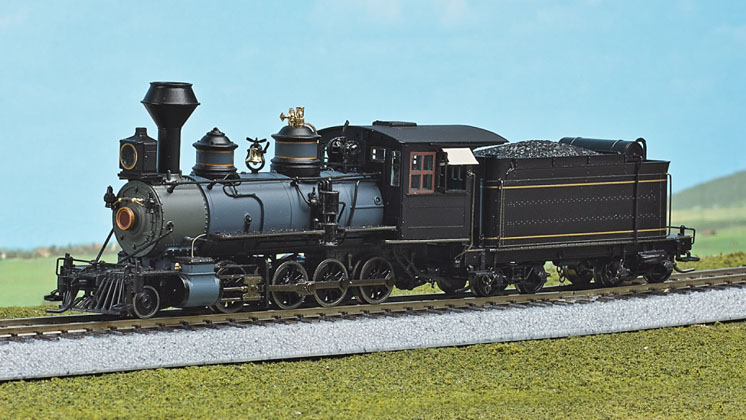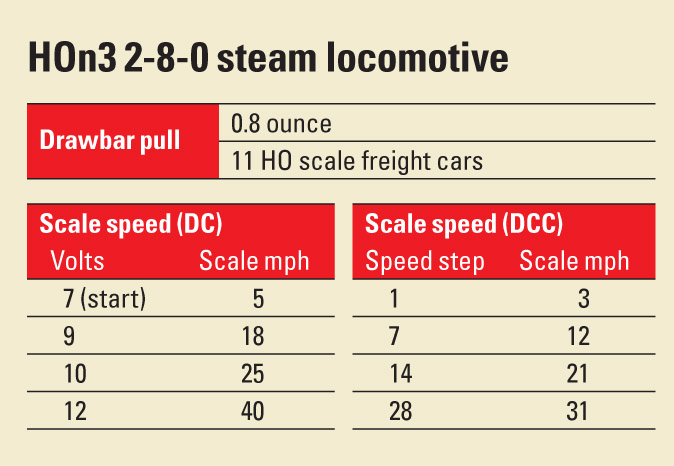The prototype. The locomotive is patterned after a Baldwin 2-8-0 built for the Denver & Rio Grande in 1881. The road was happy with the performance of earlier Baldwin Consolidations, but the line was building new, steeper tracks into rougher country, and needed beefier motive power. The twelve C-19s, also known as Class 70s for their approximately 70,000 lb. weight, were numbered 400 to 411. Slightly larger in the boiler, cylinders, and wheelbase than the earlier C-16 Consolidations, they were assigned to the Marshall Pass route between Salida and Gunnison, Colo.
In 1888 and 1889, five class C-19s were transferred to the Rio Grande Western in Utah and converted to standard gauge, then changed back by 1900 when the RGW was doing well enough to buy new motive power for its standard gauge lines.
The design was successful enough to attract orders for similar locomotives from other lines, including the Florence & Cripple Creek, Silverton Northern, and Eastern Tennesee & Western North Carolina (the “Tweetsie”).
Most of the C-19s were scrapped due to poor business during the Depression; only five made it to the start of World War II. Rio Grande Southern no. 40 were damaged in a wreck in 1943. Hollywood claimed D&RGW no. 345, which gave up the ghost in a head-on collision staged for the movie “Denver & Rio Grande” in 1951. Three are preserved and operating: RGS 41 and D&RGW 340 at Knott’s Berry Farm in California, and D&RGW 346 at the Colorado Railroad Museum.
Looking sharp. Blackstone offers the class C-19 in several D&RGW and RGS paint schemes and numbers. There’s also a painted black but unlettered version, as well as an unlettered version with a Russia iron boiler, which is the model I reviewed. The cast-metal boiler, painted a blue-gray to represent Russia iron, was smooth and even, as was the graphite smokebox. The cast-metal cab and plastic tender shell were both painted matte black. The Dulux gold striping on the tender and the steam and sand domes was straight, bright, and without gaps.
The level of detail on the locomotive is impressive. Painted wire handrails, grab irons, piping, and uncoupling levers match photos of C-19 locomotives printed in John B. Norwood’s book Rio Grande Narrow Gauge (Heimburger House, 1983). Other piping, like sand lines and air hoses, is acetal plastic. The whistle, pop valves, bell, generator, pumps, and other details are metal. The directional, light-emitting diode headlight is bright, and can be dimmed under Digital Command Control.
I wasn’t able to locate a dimensioned drawing of a C-19, but the dimensions of the model match the written description of the locomotive as a few inches bigger than the C-16 in boiler, wheelbase, cylinder, and smokebox length. The model has 36″ drivers, which matches the size given in Norwood’s book. The straight boiler is 4′-9″ in diameter; the driver wheelbase is 12′-3″; and the cylinders are 23″ in diameter.
The middle two sets of drivers on the model are “blind” (flangeless), which helps the engine negotiate tight curves and turnouts without derailing, despite its rigid wheelbase. Interestingly, this trait was shared by the prototype.
As is typical for a sound-equipped locomotive, the extra voltage draw of the sound chip makes slow-speed control tricky under DC. When starting the locomotive under DC, in addition to the chuffs, the whistle sounds automatically (twice when moving forward, three times in reverse). This drops the voltage below the decoder’s requirements, and it shuts off, then restarts. To start the locomotive under DC requires turning up the voltage up to 9V or so, high enough to overcome this; once the whistle is done sounding, the voltage can be dialed back to 7V or so, at which setting the engine will chug along at 5 scale mph.
The model’s top speed is just over 40 mph under DC control and 30 scale mph in DCC. That range is appropriate for the prototype, which was designed for pulling power on the D&RGW’s mountain grades, not for speed.
The mechanism is very smooth and quiet. When I used F8 to mute the sound effects from the DCC decoder, I had to practically put my ear to the track to hear the locomotive’s motor turning.
The sound effects were worth listening to, though. The staccato chuff of the exhaust sounded quite realistic and synched to 4 chuffs per wheel revolution of the drivers. Our sample’s whistle sound defaulted to a high-pitched peanut whistle. The SoundTraxx decoder came with seven other whistles to choose from. According to Blackstone, the versions that are painted for the Rio Grande or RGS have prototype-specific whistles as the default.I programmed CV130 to 128, increasing the bell volume so it wouldn’t be swamped by the exhaust chuffs.
Our test bench force meter recorded a drawbar pull of 0.8 ounce. That’s equivalent to a train length of 11 standard HO scale 40-foot boxcars on straight and level track. That’s typical for the prototype and era. Narrow gauge cars are smaller and lighter than standard gauge, but these trains rarely saw straight or level track, either, so that balances out. An after-market traction-tire product like Bullfrog Snot could further increase the model’s pulling power.
A Rocky Mountain high. The C-19 Consolidation represents an era of grit and ingenuity, when narrow-gauge trains climbed the Rockies. Blackstone’s HOn3 version is an excellent model, ready to conquer the mountains and canyons of your narrow gauge basement empire.
Manufacturer
Blackstone Models
210 Rock Point Dr.
Durango, CO 81301
www.blackstonemodels.com
Era: late 1870s to early 1940s
Road names: Denver & Rio Grande Western (no. 342 with Royal Gorge Route herald, no. 345 with Flying Rio Grande herald, or no. 346 in post-wreck scheme), Rio Grande Southern (no. 40 with rising sun herald, late version, or no. 41 with number on tender), painted (Russia Iron boiler) but unlettered, painted (black) but unlettered
Features
- 36″ drivers (middle two flangeless)
- Blackened metal wheelsets, in gauge
- Cast metal detail parts
- Detailed boiler backhead and cab interior
- Dimmable, directional light-emitting-diode headlight
- Five-pole, skew-wound motor with flywheel
- Kadee no. 714 knuckle couplers, at correct height
- Minimum radius: 18″
- SoundTraxx Tsunami Digital Command Control sound decoder
- Wire handrails, grab irons, and uncoupling levers















